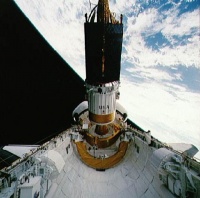TDRS-F
From The Space Library
 | |
| Organization | NASA-Office of Tracking and Data Acquisition (United States) |
|---|---|
| Mission type | Communications |
| Launch date | January 13, 1993 |
| Launch vehicle | STS-54 |
| Carrier rocket | Space Shuttle |
| Launch site | Cape Canaveral, United States |
| COSPAR ID | 1993-003B |
| Mass | 2108.0 kg |
| Experiments | Here |
| Alternate Names | TDRS 6, Tracking and Data Relay Satellite 6, 22314 |
| Nominal Power | 1700.0W |
| Additional Information | Here |
| PDMP Information | Here |
| Telecommunications Information | Here |
TDRS-F was the fifth successful launch of the Tracking and Data Relay Satellite series. TDRS-F was used in combination with other TDRS spacecraft and a ground communications system to form the Tracking and Data Relay Satellite System (TDRSS). The objective of the TDRSS program was to provide and maintain improved tracking and data acquisition services to spacecraft in low-Earth orbit. In order to fulfill this objective, TDRSS required at least two fully operational TDRS in orbit with one or more additional spacecraft serving as system spares. Each TDRS was a three-axis, momentum-biased satellite. The bus section of the spacecraft was hexagonal with an approximate diameter of 3 m. Power was provided by two opposing, three-section solar array panels, 4.0 x 3.8 m in dimension, at the end of 3.25 m booms. Perpendicular to the solar arrays were the two 4.9 m diameter, K- and S-band, single-access (SA) antennae. With the solar panels and SA antennae deployed, TDRS measured 17.3 x 14.2 m. TDRS was comprised of three functional modules: payload, spacecraft, and antenna. The payload module consisted of two single-access compartments, the multiple access antenna platform, and a main payload module. The main payload module had six panels which formed an integral part of the main bus structure and housed the principle elements of the TDRS payload. The spacecraft module contained the thermal control, electrical power, attitude control, propulsion, and tracking, telemetry, and command systems. The antenna module consisted of the two SA dish antennae, the 2.0 m K-band Space-to-Ground Link (SGL) antenna, and, on the bus of the spacecraft, the 30 helical element, multiple access (MA) antenna array, a C-band antenna, and an S-band omnidirectional SGL antenna. In addition to changes made to previous TDRS spacecraft subsequent to TDRS-A, TDRS-F had its S-band return parametric amplifiers replaced with solid-state, low-noise amplifiers.
